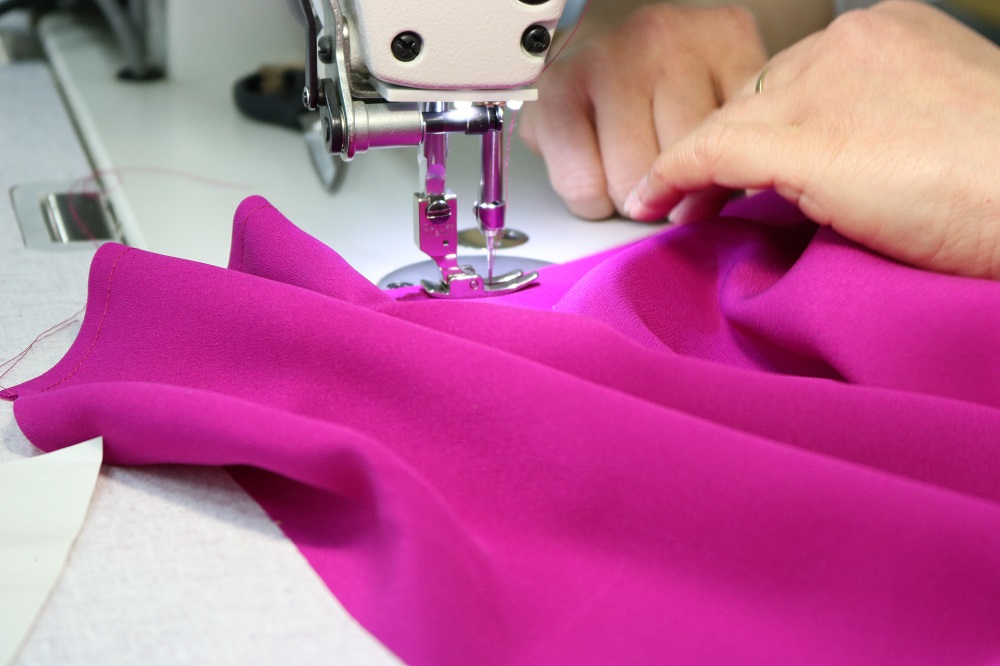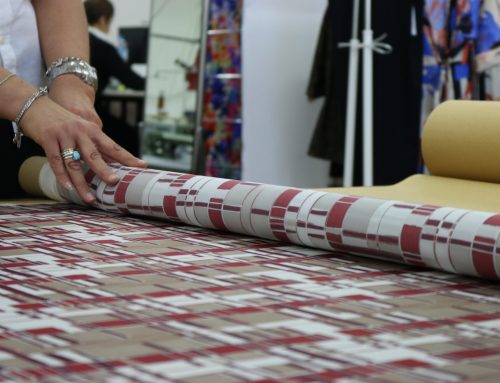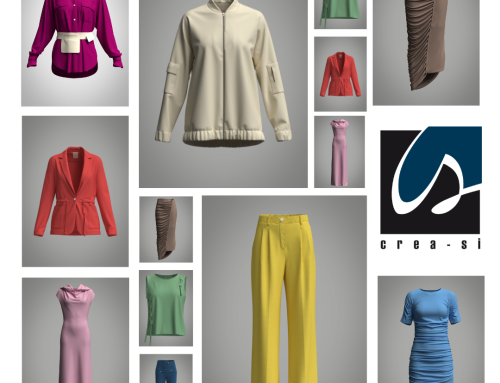
Silk, as we know, is one of the noblest and most appreciated materials in the fashion industry.
An essential fabric in classic luxury for its unique feel and distinctive characteristics.
Let’s explore together the precautions to consider when making garments from this material.
Consider the best type for your project:
There are different types of silk, each with unique characteristics. Before you begin, it’s essential to understand them and choose the one that you believe is the best option for your project, based on the type and your personal preference.
Here are some of the most common types of silk:
- Mulberry Silk: This is the most common and high-quality variety of silk. It is produced by silkworms that feed exclusively on mulberry tree leaves. Mulberry silk is known for its shine and softness.
- Tussah Silk (or Wild Silk): This type of silk is produced by silkworms that feed on leaves from wild trees like oak, chestnut, or pine. Tussah silk often has a more matte finish compared to mulberry silk.
- Charmeuse Silk: Charmeuse silk is a variation of mulberry silk known for its shine and smooth surface. It is often used for elegant pieces such as evening dresses, blouses, and nightwear.
- Chiffon Silk: Chiffon silk is lightweight and transparent. It is commonly used for lightweight garments, scarves, and wedding veils due to its delicate nature.
- Satin Silk: Satin silk has a smooth and reflective surface, thanks to a specific weaving process. It is ideal for eveningwear and lingerie.
- Crepe de Chine Silk: Crepe de Chine silk has a slightly rough and textured finish. It is known for its subtle shine and is often used for blouses, scarves, and dresses.
- Organza Silk: Organza silk is lightweight and transparent but has more stiffness compared to chiffon. It is commonly used for ruffled skirts and wedding dresses due to its ability to hold more structured volumes.
- Dupioni Silk: This silk has an irregular texture and often contains small bumps. It is known for its unique structure and is often used for formal wear.
- Georgette Silk: Georgette silk is slightly transparent with a matte finish and a slightly rough surface. It is often used for summer and lightweight garments.
- Habutai Silk (or China Silk): This silk has a smooth weave and is used for a wide range of clothing, including kimonos and casual garments.
Precautions when working with silk:
Working with silk requires careful attention and special care due to its delicacy. Here are some tips on how to work with silk when sewing a garment:
- Use appropriate needles and pins: Use fine and sharp needles, which are ideal for lightweight and delicate fabrics like silk. Ensure that the pins are thin and sharp to avoid fabric damage.
- High-quality silk thread: Use high-quality silk thread for sewing silk. These threads are smoother and less likely to break during sewing.
- Cut carefully: Use sharp and clean scissors to cut silk. Make precise cuts to avoid fraying.
- Iron or press at low temperatures: When necessary, use an iron or press at a low temperature to flatten seams and creases. Make sure to cover the silk with a protective fabric or pressing cloth to avoid direct contact with the iron.
- Hand sewing or slow machine sewing: Hand sewing can provide better control when working with delicate silk. If you use a sewing machine, reduce the speed to a minimum and use a silk or fine fabric presser foot.
- Use lightweight and subtle stitches: Avoid heavy or densely spaced stitches that can damage the fabric. Opt for lighter and more delicate stitches that better suit the lightweight nature of silk.
- Edge finishing: To prevent fraying, you can apply edge sealant or overlap the edges before sewing.
- Pay attention to finishing: Finishing touches like rolled hems, French seams, or invisible stitches can provide an elegant touch to your silk garments.
- Care and cleaning: Provide detailed instructions on how to care for silk garments, as silk often requires handwashing or dry cleaning.
- Practice first: If you have limited experience working with silk, practice on fabric samples before starting your main project to gain confidence.
Remember that practice is essential when working with silk. You will better understand its characteristics as you gain experience sewing this delicate and luxurious fabric.
What are the best finishes to enhance a silk garment?
Finishes are an essential element in enhancing silk garments, improving their appearance and durability. Here are some finishes that can add a special touch to your silk garments:
- Rolled hems: Rolled hems, created by gently folding and sewing the fabric, are a classic choice for silk. This finish gives a clean and refined look.
- French seams: French seams are hidden seams that cover the edges of the fabric. They are ideal for preventing fraying and providing an elegant, seamless finish.
- Silk ribbons or trims: Adding silk ribbons or trims as decorative details can enhance your garments. You can use them along the hems, cuffs, or as decoration on the front of a blouse.
- Silk lace or lace trim: Incorporating silk lace or lace trim can give a romantic touch to silk garments, especially for lingerie or bridal wear.
- Invisible zippers or buttons: For more formal garments such as evening dresses or jackets, using invisible zippers or buttons helps maintain a clean finish without visible closures.
- Covered silk buttons: Creating covered buttons with the same silk fabric as the garment is an elegant way to add personalized details.
- Ruffles and pleats: Ruffles or pleats in silk can be used to create three-dimensional structure and add elegance to garments like skirts or cocktail dresses.
- Silk appliqué: You can add silk appliqué, such as flowers, butterflies, or other decorative motifs, to personalize your garments.
- Embroidery: Hand or machine embroidery can enrich your silk garment with intricate details and a craftsman’s touch.
- Silk lining: Adding a silk lining inside the garment not only provides comfort but also an elegant and finished appearance.
What are the best styles for this fabric?
Thanks to the wide variety of silk types and weaves, you can obtain softer and lighter fabrics as well as more rigid weaves.
In general, silk is a very versatile fabric that can be used for a wide range of clothing, from formal to casual, from traditional to contemporary. The choice of the pattern will depend on your personal preferences and the intended use of the garment.
- Evening dresses: Silk is a classic choice for evening dresses, including cocktail dresses, long evening gowns, or wedding dresses. Its shine and softness make it perfect for special occasions.
- Blouses and shirts: Silk blouses and shirts are refined and comfortable to wear. Silk charmeuse or silk crepe de chine are often used to create these garments.
- Pleated skirts: Silk pleated skirts offer an elegant and lightweight appearance. Silk is an ideal fabric for pleats and pleating due to its lightness.
- Nightshirts and underwear: Silk is a luxurious choice for nightwear, such as camisoles, pajamas, or robes. It is soft against the skin and offers comfort.
- Scarves and shawls: Silk is often used to create scarves and shawls due to its transparency and its ability to hold warmth when needed.
- Kimonos and traditional clothing: Silk is a traditional fabric for Japanese kimonos, Indian saris, and other traditional clothing from various cultures.
- Accessories like ties and pocket squares: Silk is widely used to create ties and pocket squares because of its shine and print possibilities.
- Lightweight summer clothing: Silk georgette or silk chiffon are excellent choices for lightweight and breathable summer clothing due to their lightness.
- Office jackets and dresses: Silk can also be used for office jackets or dresses, adding an elegant touch to your professional wardrobe.
Do you want to create garments in silk?
Crea-Si can help you, with thirty years of experience in the creation of clothing in many different fabrics.
Contact us for more information or to present your project!





